 |
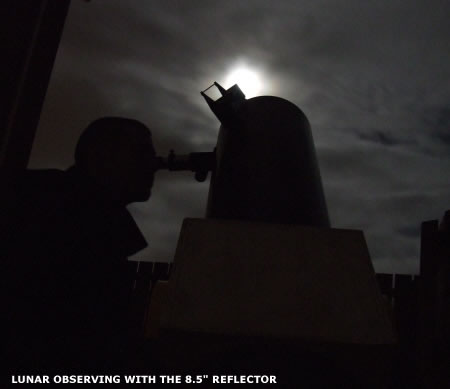 |
The first Moon event of 2007 occurred on March 2nd and it was a very interesting one depending on what part of Ireland or the United Kingdom you live in. For those who live along a line joining the Scottish west coast through the Merseyside area the West Midlands and just east of Portsmouth would see a rare 'Grazing Occultation' of the planet Saturn. For those east of this line a full occultation occurred and the ringed planet was covered in full or part by the Moon. For those west of the line no occultation occurred however the Moon was virtually inseparable from the ringed planet to the naked eye. Telescopes revealed a truly stunning sight as this wonderful planet passed by the limb of the Moon. The event occurred very close to 02.35 UT (allow a couple of minutes for other locations). Those along the line of the grazing occultation seen Saturn perform an amazing set of dimming and disappearing and then re-appearing as it passed behind mountains and craters on the Moon's limb. |
The evening of March 1st was crystal clear and I had already been out for several hours observing and imaging the Moon with the basic equipment I had available. With the naked eye planet Saturn looked like a steady golden star several degrees to the SW of the waxing gibbous Moon (2 days from full). I spent a great deal of time observing the gorgeous terminator with the 9.7mm high power eyepiece. What caught my attention was the beautiful complex light and shadowed region opposite the 'Bay of Rainbows' where the large elongated impact crater Pythagoras dominated the view - exquisite!
The long period variable star Mira was still bright in the SW not far off the magnitude of Polaris, this star is currently experiencing one of its best maxima in years looking like a ruby-red Nova breaking up the constellation of Cetus the 'Whale'. Mighty planet Venus blazed like a Supernova low in the west above the tree tops near the Coleraine road which was a striking sight. This glorious planet now sets after 20.00 UT - a far cry from the time I seen it along with great comet Mc Naught back in January when it was close to the sun and hidden within the bright glow of twilight. By 22.00 and before wrapping up this peaceful evening session I glanced back up to the Moon and Saturn. Yip it was obvious that the two bodies were getting closer together for a spectacular sight later in the night. I just hoped the sky stayed clear.
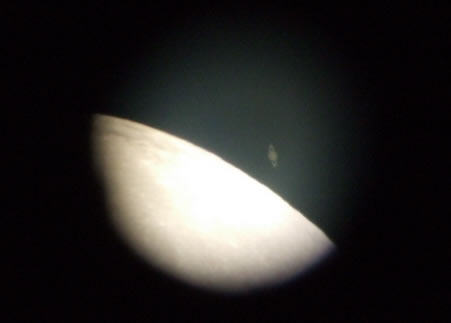 |
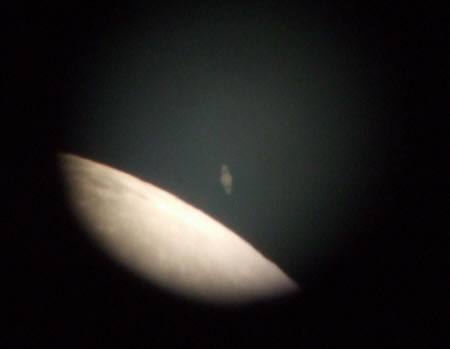 |
The weather forecast was looking very good indeed. At 01.00 UT I received a phone call from John Mc Connell who was also waiting patiently for the time of conjunction. He informed me that clouds had moved into his location to the extent that he could no longer see the Moon which caused us much concern however we remained positive and discussed the event which was now closing in fast. Meanwhile my sister and I decided to go for a five mile walk through the local countryside. I never pass up an opportunity to go on a late night country walk as it is often at times like these when one serendipitously observes some spectacular transient event in the sky such as shadow casting fireballs or the magnificent aurora borealis. By 01.30 things were not so good. The sky was 95% overcast with moonlit altostratus clouds which subdued the Moon in magnitude. Small clear gaps combined with these denser concentrations of cloud caused the ground and trees to rapidly brighten and darken again like some giant strobe light with fading battery power pointing down from the sky casting eerie moving shadows across the narrow road. Things were not looking good at all.
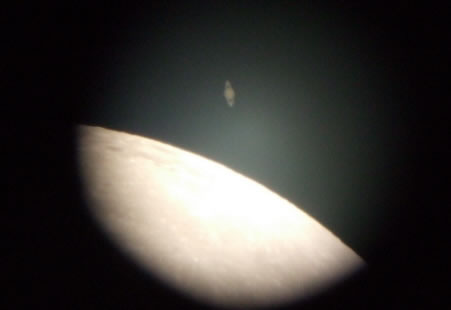 |
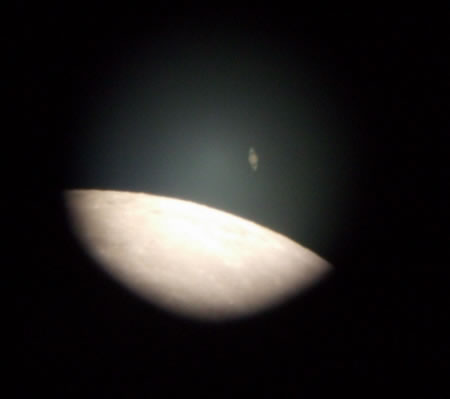 |
We were on our way home and things were looking prosperous. A large clear gap had appeared over the distant mountains low in the west and since the clouds were drifting from west to east I predicted that I would have a crystal clear sky very soon. I arrived back home at 02.20 and everything had fallen into place like clock work - it was clear!
I had a quick cup of tea then headed out to the back garden where I set up the homemade 8.5" F/7 dobsonian reflector beside which stood my tall tripod with Fuji S5600 5.1MP digital camera mounted on top. The sky was superb! - 95% clear with just a few distant non threatening stratus clouds low in the south over the Slieve Gallion mountain range. Transparency = 8/10, completely calm, quiet with a very heavy frost (- 3*C) which covered the grass, roof tops and car in a crusty white blanket. High in the SW was the brilliant Moon above my neighbours roof casting its cold light across the garden. It was located within Leo but this time Saturn could not be seen with the naked eye - it was too close to the Moon!
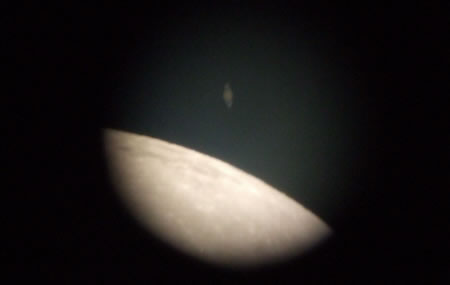 |
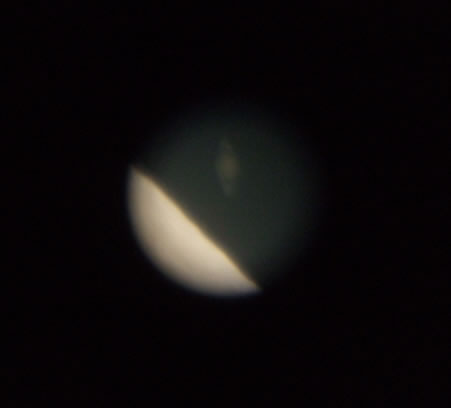 |
Time = 02.30 UT. I inserted my high power 9.7mm eyepiece into the focuser and guided the telescope onto the Moon - WOW!!! This was even better than what I expected. Planet Saturn and the Moon both shared the same
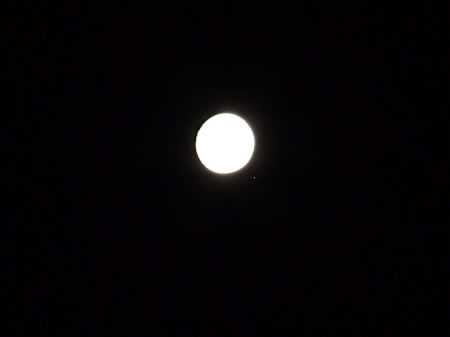 |
high power field of view, in fact Saturn was only about one ring diameter away from the Moon's northern sunlit limb. They were almost touching and the difference between the two was beyond words. It was a complete shock to see these two incredible telescopic sights in such close proximity to one another - I reckon many more people would be interested in astronomy after seeing a visual treat like this. Within seconds the motion of the Moon and Saturn was apparent. Saturn seemed to silently creep up to the Moon tantalizingly close and gently drift along its edge like two great vessels passing in the ocean within the dead of night! Despite the average seeing (5/10) the view of Saturn was stunning. I could see its slightly subdued golden - orange form in tack sharp detail with plenty of features on show: A, B rings, shadow of the rings on the sun ward side of the 'ball', Cassini division, equatorial band |
and bright white zone and polar shading. The Moon boasted an incredible range of giant lunar seas and impact craters with valleys, mountains and ridges. Saturn looked so tiny beside the incredible size of our own satellite however this was just a visual illusion because in reality the Moon could fit inside the ringed world countless times. I inserted the wide angle 40mm eyepiece and began taking images with my camera hand held to the occular which was extremely difficult due to the Fuji's small FOV, the undriven scope and my shaking hands because of the frost. After a little experimentation I ended up filling my memory card with images twice over. I think the results were pretty good!
Saturn and the Moon were now drifting apart and by 04.00 I could see Saturn with the naked eye (see above image) now to the west of the Moon which signaled the end of the session. John and I had been sending text messages back and fourth (the neighbours think I am weird enough without hearing beeping noises from my garden at 4 am) throughout the event. John was hampered by clouds during closest approach however by 02.45 it cleared and he got a great visual view which delighted him also.
I spent a relaxing twenty minutes comparing the Moon and planet in the same field and could imagine in ancient times some great comet falling inwards from the Oort cloud, invisible from the Earth as it passed by Saturn getting gravitationally perturbed in its orbit so the icy projectile is sling shot towards the inner solar system where it grows an immense bright tail and impacts the Moon in its southern hemisphere creating the bright impact crater Tycho which I could now see with long fractured rays spread across the lunar landscape composed of countless craterlets. Yip I was day dreaming (or is that night dreaming?) but the event tonight which I had just observed showed that the solar system is a very dynamic place indeed! I watched as the Moon continued along its slow eastward trek along the ecliptic. However the action was not over yet - in two days time it will pass through the Earth's shadow causing a total lunar eclipse! (read the report).
Session ended at 04.20 UT - A complete success! - I retired to bed feeling very satisfied!
See you after the eclipse.
Martin Mc Kenna